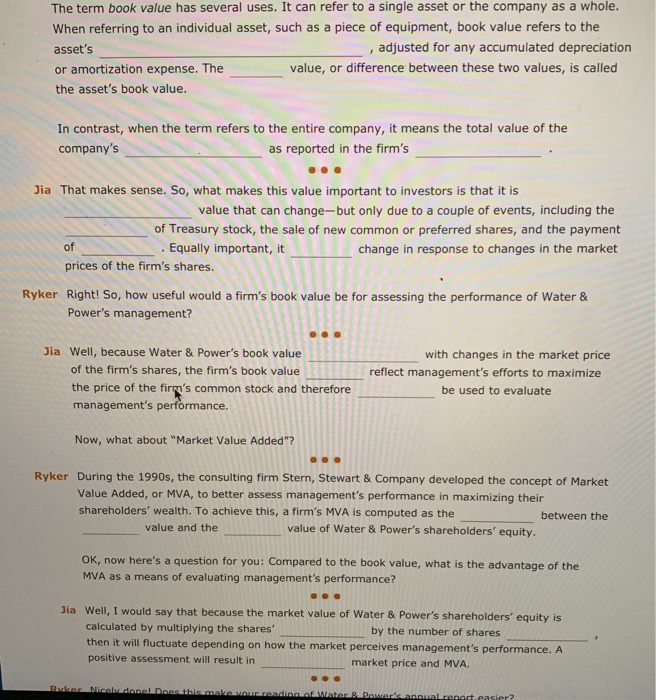The term book value has several uses. It can refer to a single asset or the company as a whole. When referring to an individual asset, such as a piece of equipment, book value refers to the asset's , adjusted for any accumulated depreciation or amortization expense. The value, or difference between these two values, is called the asset's book value. In contrast, when the term refers to the entire company, it means the total value of the company's as reported in the firm's Jia That makes sense. So, what makes this value important to investors is that it is value that can change-but only due to a couple of events, including the of Treasury stock, the sale of new common or preferred shares, and the payment of . Equally important, it change in response to changes in the market prices of the firm's shares. Ryker Right! So, how useful would a firm's book Power's management? for assessing the performance of Water & Jia Well, because Water & Power's book value of the firm's shares, the firm's book value the price of the firm's common stock and therefore management's performance. with changes in the market price reflect management's efforts to maximize be used to evaluate Now, what about "Market Value Added"? Ryker During the 1990s, the consulting firm Stern, Stewart & Company developed the concept of Market Value Added, or MVA, to better assess management's performance in maximizing their shareholders' wealth. To achieve this, a firm's MVA is computed as the between the value and the value of Water & Power's shareholders' equity. OK, now here's a question for you: Compared to the book value, what is the advantage of the MVA as a means of evaluating management's performance? Jia Well, I would say that because the market value of Water & Power's shareholders' equity is calculated by multiplying the shares' by the number of shares then it will fluctuate depending on how the market perceives management's performance. A positive assessment will result in market price and MVA. Radio Micaledonel Donbis make our reading of Mater Damerannual report easier? The term book value has several uses. It can refer to a single asset or the company as a whole. When referring to an individual asset, such as a piece of equipment, book value refers to the asset's , adjusted for any accumulated depreciation or amortization expense. The value, or difference between these two values, is called the asset's book value. In contrast, when the term refers to the entire company, it means the total value of the company's as reported in the firm's Jia That makes sense. So, what makes this value important to investors is that it is value that can change-but only due to a couple of events, including the of Treasury stock, the sale of new common or preferred shares, and the payment of . Equally important, it change in response to changes in the market prices of the firm's shares. Ryker Right! So, how useful would a firm's book Power's management? for assessing the performance of Water & Jia Well, because Water & Power's book value of the firm's shares, the firm's book value the price of the firm's common stock and therefore management's performance. with changes in the market price reflect management's efforts to maximize be used to evaluate Now, what about "Market Value Added"? Ryker During the 1990s, the consulting firm Stern, Stewart & Company developed the concept of Market Value Added, or MVA, to better assess management's performance in maximizing their shareholders' wealth. To achieve this, a firm's MVA is computed as the between the value and the value of Water & Power's shareholders' equity. OK, now here's a question for you: Compared to the book value, what is the advantage of the MVA as a means of evaluating management's performance? Jia Well, I would say that because the market value of Water & Power's shareholders' equity is calculated by multiplying the shares' by the number of shares then it will fluctuate depending on how the market perceives management's performance. A positive assessment will result in market price and MVA. Radio Micaledonel Donbis make our reading of Mater Damerannual report easier







